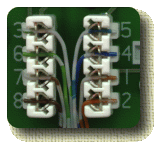Wiring up ISDN

Cable
Standard Cat5 UTP (Unscreened Twisted Pair) cable is recommended for all types of telephone station wiring, and should always be used for ISDN cabling applications.
Cat5 cable is color coded in 'pairs', and each 'pair' consists of two wires twisted together within the cable. You should always use these pairs, and never mix up the wires from different pairs (colors).
The coloring is normally done by having one wire in the pair white with colored bands (an 'A' wire), and the other in the pair colored with white bands (a 'B' wire).
IDC
Insulation displacement connectors (IDC) are a quick and reliable way of connecting solid Cat5 cable to sockets and connectors. The contacts do not work loose, and there is less risk shorting. You can normally even punch up to four wires in to each IDC point if necessary. Use only a proper IDC tool, never a screwdriver!
ISDN Sockets
ISDN distribution uses standard RJ45 (8 way) sockets, as used for Ethernet (10baseT) networks. Note that while computer (10baseT) and ISDN connectors and cable are the same, the pairs are different. Care should be taken!
Wiring
The station wiring for a Basic Rate ISDN line must be daisy chained: each socket, connecting back to the last, and back to the NT unit (all sockets are wired in series). You can either have one terminal up to 800m away from the NT unit, or any number within 150m (total cable length). The last socket on the cable must have terminating resistors enabled, and the NT must have it's termination turned off. The sockets can be ordinary RJ45 data sockets except the last which must have 100R terminating resistors installed across 3-6 and 4-5. The polarity should be preserved.

There are usually two switches on the NT (box connecting to the incoming line). One is marked IN/OUT, and sets the internal (100R) terminating resistors either in or out of circuit. The other is marked L/S, indicating long or short lines. For cable runs over 150m the NT must be set to long cabling timing
You can wire ISDN using just two pairs (4/5 and 3/6) as the additional two pairs are optional power lines. The optional power lines are not used by most ISDN phones as there is also power provided on 3/4/5/6. Note that a UK ISDN line does not have enough power to run a normal (Euro) ISDN phone.
Assign Pairs as follows:-
| Pin # | Wire Color | 10baseT | Tel. | ISDN |
 | |
|---|---|---|---|---|---|---|
| 1 | White/Orange |  | Tx+ | Power 3 - optional | ||
| 2 | Orange/White |  | Tx- | |||
| 3 | White/Green |  | Rx+ | TE->NT + | ||
| 4 | Blue/White |  | B wire | NT->TE + | ||
| 5 | White/Blue |  | A wire | NT->TE - | ||
| 6 | Green/White |  | Rx- | TE->NT - | ||
| 7 | White/Brown |  | Power 2 - optional | |||
| 8 | Brown/White |  | ||||
Legend:
- TX - Transmit
- RX - Receive
- A wire - Tip
- B wire - Ring
- TE - Customer Terminal Equipment
- NT - Network Terminator (PTT Supplied).